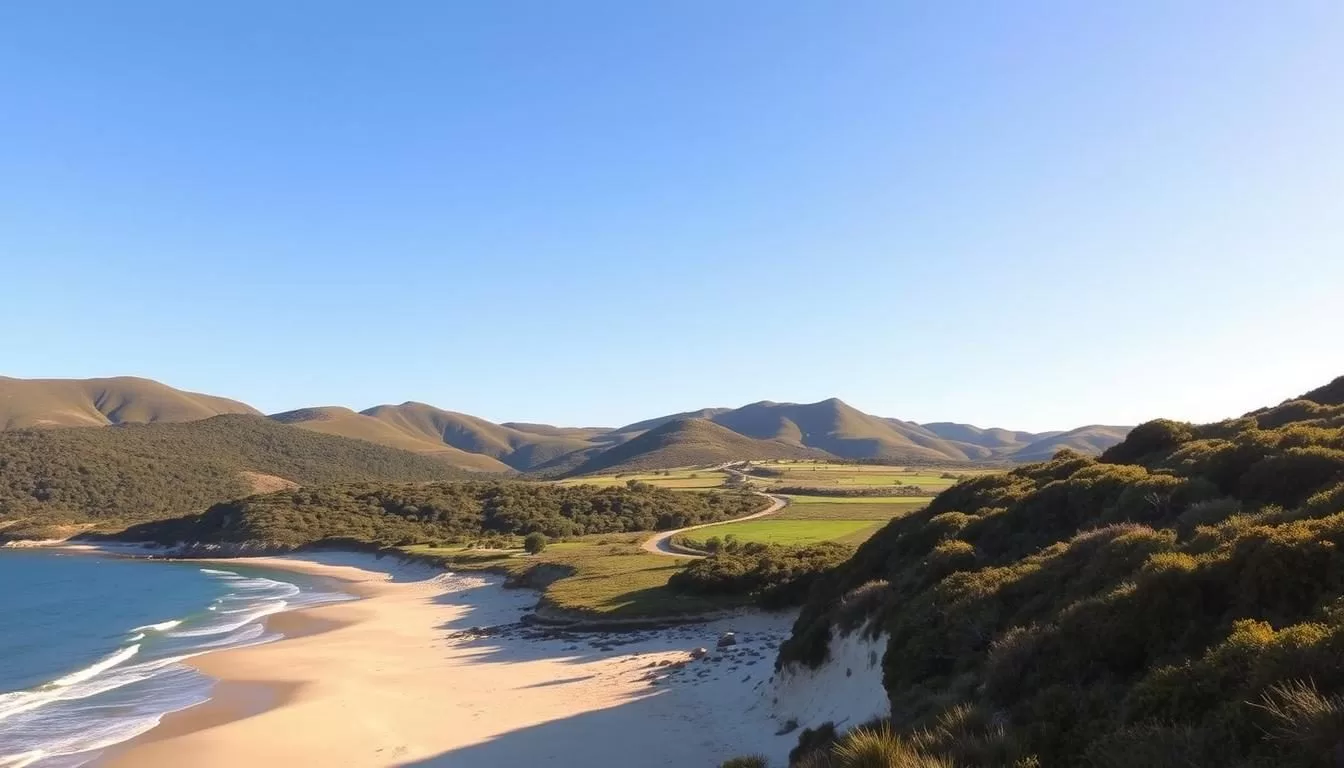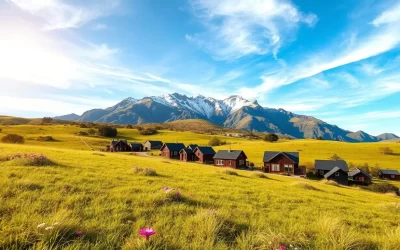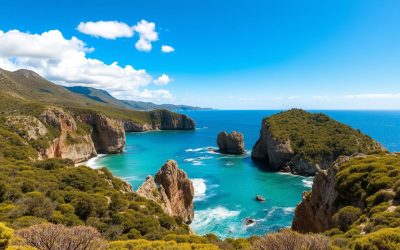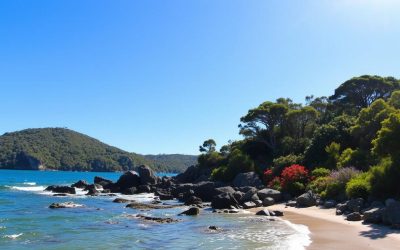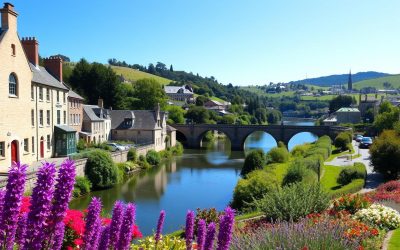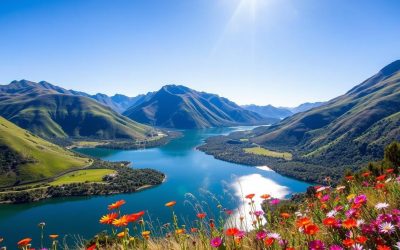Planning your next getaway? Timing is everything when it comes to enjoying the outdoors and making the most of your trip. This guide is here to help you find the best time to visit, ensuring you experience the most favorable weather conditions for your adventures.
Understanding seasonal trends is key to planning a successful trip. Whether you’re into scenic walks, alfresco dining, or cultural tours, knowing when to go can make all the difference. For instance, autumn brings mild temperatures and fewer crowds, making it a popular choice for travelers1.
This article breaks down the weather patterns and highlights the ideal periods to visit. You’ll learn why timing your trip matters and how to avoid extreme conditions. With this knowledge, you can plan a seamless journey and enjoy every moment to the fullest.
Introduction: Planning Your Weather-Savvy Trip to Tasmania
Understanding the climate is the first step to planning a memorable trip. This destination offers a unique blend of weather patterns that vary by region and season. Whether you’re exploring coastal areas or highlands, knowing what to expect can help you pack smarter and enjoy more.
Overview of the Unique Climate
The temperature here ranges widely throughout the year. In May, for example, it can drop to 3°C or rise to 14°C, depending on the region2. Coastal areas tend to be milder, while highlands can be cooler and more unpredictable. This diversity makes it essential to research before you go.
Seasonal shifts also affect daylight and outdoor activities. Autumn, for instance, is known for its mild weather and fewer crowds, making it a favorite among visitors3. Planning around these trends ensures you get the most out of your trip.
Why Timing Your Visit Makes All the Difference
Timing your visit isn’t just about avoiding bad weather. It’s about enhancing your experience. For example, festivals and cultural events often align with specific seasons. Outdoor adventures, like hiking or wildlife watching, are also more enjoyable during certain times of the year2.
Here are a few reasons why timing matters:
- Better weather conditions for outdoor activities.
- Fewer crowds during off-peak seasons.
- Opportunities to experience local festivals and events.
With over 19 national parks and 12 wine regions, this destination offers something for every visitor2. By planning ahead, you can make the most of your time and create unforgettable memories.
Understanding Tasmania’s Seasons and Weather Patterns
Exploring seasonal changes can elevate your travel experience. The climate here varies significantly by season and region, offering unique opportunities for adventure. Whether you’re drawn to the coast or the mountain peaks, understanding these patterns ensures you’re prepared for any weather.
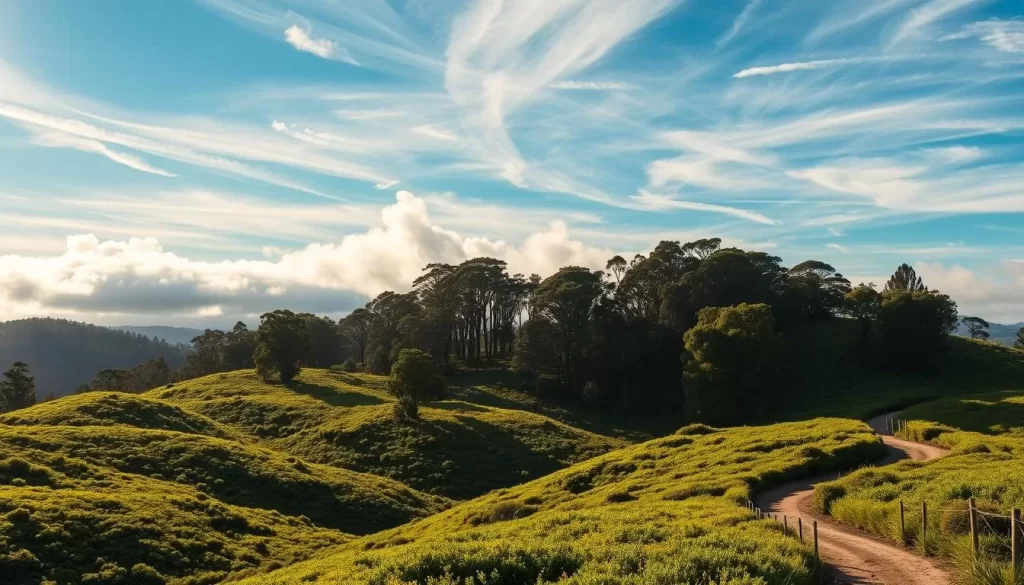
Seasonal Temperature Ranges and Variations
Summers are mild, with average temperatures ranging from 17°C to 23°C (63°F to 73°F)4. Winters, on the other hand, can be chilly, with highs around 12°C and lows dropping to 3°C4. These shifts affect everything from outdoor activities to packing essentials.
Rainfall is another factor to consider. The western regions receive more rain, while the east coast tends to be drier4. This diversity means you’ll need to plan differently depending on where you’re headed.
Regional Climate Differences: From Coastal to Highlands
Coastal areas enjoy milder weather year-round, thanks to the moderating influence of the ocean. In contrast, the highlands, including areas like Cradle Mountain, experience more extreme conditions4. Snow is common in these regions during winter, making them ideal for cold-weather enthusiasts.
Southern Ocean squalls can bring sudden changes, especially in the highlands. These storms often lead to cooler temperatures and occasional snow at higher altitudes4. If you’re planning a trip to the mountains, pack layers and be ready for anything.
By understanding these regional nuances, you can choose the season that aligns with your interests. Whether you prefer coastal breezes or mountain adventures, knowing what to expect ensures a memorable journey.
Tasmania, Australia: Best Months for a Weather-Savvy Trip
Each season offers its own unique charm, making it essential to choose the best time year for your visit. Whether you’re drawn to warm, sunny days or cozy winter evenings, understanding the seasonal highlights ensures a memorable trip.

Summer Delights and Autumn Ambiance
Summer brings long, sunny days perfect for outdoor activities. Average temperatures exceed 20°C, making it ideal for beachcombing, scenic hikes, and alfresco dining5. The Sydney Hobart yacht race is a must-see event, drawing visitors from around the world.
As summer transitions to autumn, the weather remains mild, and the landscape transforms into a vibrant palette of reds and golds. February and March are quieter, offering a peaceful option for outdoor adventures like hiking and kayaking5.
Winter Wonders and Spring Blooms
Winter is a time for cozy indoor experiences and unique events like the Dark MOFO festival. Snow often blankets the highlands, creating a magical setting for cold-weather enthusiasts5. It’s also a great time to explore local wine regions, as fewer crowds mean more personalized tastings.
Spring breathes new life into the region, with blooming parks and active coastal scenes. The weather is mild, making it a best time year for exploring national parks and enjoying outdoor festivals5.
| Season | Highlights | Best Activities |
|---|---|---|
| Summer | Warm, sunny days | Beachcombing, hiking, alfresco dining |
| Autumn | Mild weather, colorful landscapes | Hiking, kayaking, wine tours |
| Winter | Snowy highlands, cozy festivals | Indoor events, wine tastings |
| Spring | Blooming parks, mild weather | Outdoor festivals, scenic walks |
By choosing the right season, you can tailor your trip to match your interests. Whether you prefer summer’s warmth or winter’s charm, there’s an option for every person.
Must-Visit Attractions and Tours in Every Season
Discover the perfect blend of history and adventure on your next trip. Whether you’re drawn to cultural landmarks or outdoor escapades, there’s something for every traveler. From immersive tours to seasonal festivals, this guide highlights the top experiences you shouldn’t miss.

Cultural Heritage and Historical Sites
Step back in time with a visit to Port Arthur, a UNESCO World Heritage Site. This historic location offers a glimpse into the convict era, with guided tours that bring its stories to life6. Explore the ruins, gardens, and museums that paint a vivid picture of the past.
For a deeper dive into local history, consider a tour of the island’s many heritage sites. From colonial architecture to ancient Aboriginal landmarks, these locations offer a rich cultural experience. Don’t miss the chance to learn about the region’s unique history through engaging storytelling and interactive exhibits.
Outdoor Adventures, Festivals, and Scenic Walks
If you love the outdoors, you’re in for a treat. The island boasts over 880 walking tracks, perfect for exploring its stunning landscapes7. Whether you’re hiking through a national park or strolling through a lush garden, there’s no shortage of scenic routes to enjoy.
For a taste of local produce, visit the Huon Valley. Known for its apples, cherries, and fine wines, this region offers vineyard tours and farmers’ markets7. Pair your visit with a wine-tasting experience to savor the flavors of the area.
Every season brings its own festivals and events. From food and wine celebrations to art fairs, there’s always something happening. Plan your time year visit around these events to make the most of your trip7.
For more budget-friendly activities, check out these free experiences that showcase the region’s natural beauty and cultural offerings.
City and Regional Highlights: Hobart, Launceston, and Beyond
Discover the vibrant urban centers and scenic landscapes that make this destination unforgettable. From bustling waterfronts to rugged mountain peaks, these cities offer a perfect blend of culture, history, and nature.
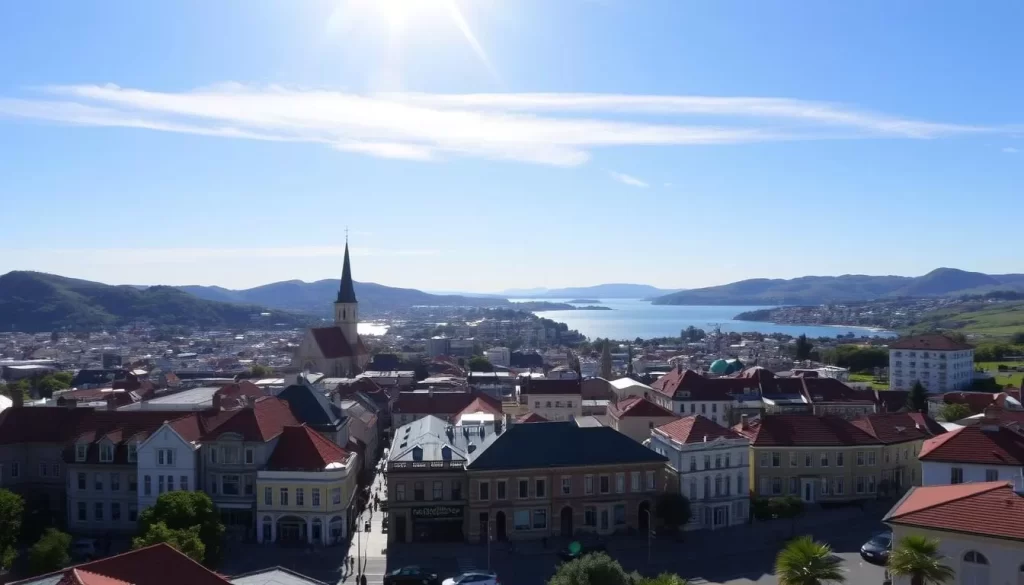
Exploring Hobart’s Waterfront and Mount Wellington
Hobart, the capital city, is a hub of activity and charm. Its waterfront is a lively spot, lined with cafes, galleries, and historic buildings. Take a stroll along the docks, where the sea breeze mingles with the aroma of fresh food from local vendors8.
Just a short drive away, Mount Wellington towers over the city. This iconic peak offers panoramic views of the surrounding landscape. Whether you hike or drive to the summit, the experience is unforgettable. The mountain is a gateway to outdoor adventures, from hiking trails to scenic lookouts9.
Discovering Launceston, Cradle Mountain, Strahan, and Freycinet
Launceston, known for its old new heritage precincts, is a treasure trove of history and culture. Explore its Victorian architecture, vibrant markets, and world-class wineries. The city is also a gateway to the stunning Cataract Gorge, where nature meets urban life8.
For those seeking rugged beauty, Cradle Mountain is a must-visit. Its dramatic peaks and serene lakes are a hiker’s paradise. Strahan, on the west coast, offers a mix of history and natural wonders. Freycinet, with its pristine beaches and pink granite peaks, is a destination for nature lovers9.
- Hobart’s waterfront: A blend of history and modern culture.
- Mount Wellington: A scenic spot for outdoor enthusiasts.
- Launceston: A city rich in heritage and culinary delights.
- Cradle Mountain, Strahan, and Freycinet: Nature’s finest offerings.
These cities and regions come together to create a complete experience. Whether you’re exploring urban centers or venturing into the wild, each destination offers something unique. For more insights into Hobart’s top attractions, check out this guide.
Essential Packing and Trip Planning Tips
Getting ready for your journey requires careful preparation to handle unpredictable weather. The region’s climate can shift dramatically in a single day, so packing smart is key to staying comfortable. Layering is your best friend, allowing you to adapt to changing conditions without overpacking.
Smart Packing for Changing Weather Conditions
Start with versatile clothing that can be layered. A lightweight jacket, a waterproof shell, and moisture-wicking base layers are essential. Rainfall can vary, so always pack a compact umbrella or raincoat10. For colder months, add a warm sweater or fleece to your list.
Footwear is equally important. Choose sturdy, waterproof shoes for outdoor activities and comfortable walking shoes for exploring the capital city. Don’t forget accessories like a hat, gloves, and sunglasses to protect against sun and wind.
- Pack a mix of short and long-sleeved tops.
- Include a waterproof layer for sudden rain showers.
- Bring a small backpack for day trips.
Booking Accommodations, Tours, and Planning Your Calendar
Booking your accommodation early ensures you get the best options for your budget and style. Whether you prefer a cozy cabin or a modern hotel, planning ahead saves you stress and money. Peak travel periods fill up quickly, so secure your stay as soon as possible.
When planning your calendar, consider the time year and the activities you want to enjoy. Popular tours and events often require reservations, so book these in advance. For example, festivals and guided hikes are best reserved early to avoid disappointment11.
Here are a few tips to maximize your trip:
- Research local events and festivals to align with your visit.
- Book tours and activities at least a month in advance.
- Check the weather forecast closer to your travel dates to adjust your packing list.
For more essential tips for planning a trip, explore this comprehensive guide to make your journey seamless and enjoyable.
Conclusion
Understanding the climate and seasonal patterns is key to making the most of your journey. From national parks to hidden gems like Bruny Island, every thing contributes to the region’s unique charm. Whether you’re hiking through lush trails or enjoying coastal views, careful planning ensures you experience it all at its best12.
Use this guide as your roadmap to uncover breathtaking views and diverse attractions. Timing your visit allows you to enjoy everything from vibrant festivals to serene landscapes. With proper preparation, you can explore the region’s wonders, no matter the season13.
Start planning your adventure today. The unforgettable views and multifaceted experiences await. For more tips on traveling on a budget, check out this helpful resource. Your journey is just a step away, ready to be filled with memories that last a lifetime.
Source Links
- Your Month-to-Month Guide to Australia: Weather, Events, & Holidays
- Next Stop – Tasmania! – Traveling Honeybird
- Australia Travel Guide: Complete Travel Guide & Tips
- Australian Luxury Escapes Blog | Must Do In Australia
- The best time to book a trip in Australia: When to go
- December in Australia: Weather, What to Pack, and What to See
- Indulge in Tasmania’s Gastronomic Paradise | Food and Wine Tours
- World’s Best Road Trips – According to Travel Bloggers — The Upbeat Path
- Best Months for a Weather-Savvy Trip – TRAVEL.COM®
- May in Australia: Weather, What to Pack, and What to See
- The Tasmanian Overland (Cradle Mountain) Track: A Hiking Guide – Sarah Wilson
- US & Canada’s national parks: best time to visit? – Lonely Planet
The above is subject to change.
Check back often to TRAVEL.COM for the latest travel tips and deals.
